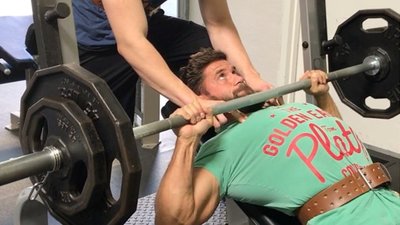Julian Smith stands up for some of the things that many lifters either love to hate, or just plain overlook. A few of his favorites: Smith machines, sissy squats, and drawing out the negative—and I mean really drawing it out.
This former multi-sport athlete had multiple collegiate offers to play football, but he realized the downside of such a punishing sport after sustaining multiple concussions his senior year. Faced with the closing of one athletic avenue, he turned to bodybuilding. Since then, he's built a pair of legs that earned him the nickname "The Quad Guy," as well as a cult-like following online for his open-minded approach to training and his ability to craft innovative updates of gym classics.
In general, Smith gravitates toward the old-school method of training—a no-bullshit approach that seriously controls the eccentric portion of lifts in each exercise to maximize gains.
"The negative is what is stopping the weight from actually going all the way down," Smith explains. "Lengthening the negative engages more muscle fibers and makes your muscle work more."
Here are Smith's top five exercises to turn around and slow down. Slow negatives can produce DOMS like nothing else, though, so handle with care, lighten the weight, and be prepared to struggle—in a good way.
1. Wide-Grip D-Handle Pull-up
When it comes to upper-body pulling strength, the pull-up is king. But by focusing on how many reps they can do—either to hit certain rep ranges or to finish high-intensity workouts—many lifters end up doing high-speed, momentum-heavy reps that limit their strength and muscle gains.
Smith's solution is to push the time under tension through the roof by slowing the lowering half of the pull-up down to a crawl.
"You will see more benefits from these than almost any other exercise!" he promises.
Notice anything else out of the ordinary? By putting a wide D-grip attachment on top of the normal neutral-grip bar, Smith gets the lat activation benefits of a wide grip, without making his grip strength a limiting factor.
All of his videos are like that. Pay attention, and you'll see there's a lot of thought put into every detail.
But Smith says most of his hacks and tweaks were borne out of necessity.
"I started at a gym where they had one lat pull-down machine, one preacher curl machine, and one squat rack," he says. "If you got there at a busy time, you'd wait 30 minutes minimum to get the machine you wanted. I'd find all the different variations—because I didn't want to wait."
2. Deadlift
The deadlift is not the most obvious choice for increased time under tension. In fact, many lifters advocate straight up dropping every rep from the top, and swear that to do anything slower is downright dangerous. But as Smith explains, if you're not feeling deadlifts in your lats, hamstrings, and glutes, the answer isn't to chase bigger numbers—it's to pump the brakes and slow this movement down.
Smith hits deads with 8-10-second negatives per rep. Seriously! As you can see in the video, he even uses the stopwatch on his phone to help keep him honest.
"I rarely do deads anymore," he notes, "but I make sure I get them in every second or third back workout, and I've seen way more benefits slowing it down to make the back really work."
The key to incorporating longer negatives is understanding when and where to slow down—and how to maintain your focus. Smith's concentric reps are quick and forceful. It's almost like he's performing the rep in reverse—and that's the point. If the weight is one you can barely get off the ground, this approach won't work for more than a shaky rep or two. But if you can control the weight, you'll find that your muscles must stay under constant tension to lower the weight.
"I get a little bit of pushback," says Smith, of online commenters. "I've had people say, 'oh, you don't need to go that slow,' and—I don't want to sound cocky—it's almost like the proof is in the pudding."
3. Smith Machine Flat Bench
Think the only way to bench is with two feet on the floor, two hands on a barbell, and your heart set on big numbers? Smith asks you to consider an entirely new approach.
"I'd rather do the lightest amount of weight possible if it's going to stimulate my muscles the right way," he says.
Most spotters would snooze from boredom watching a 10-second negative on every rep of the bench press. That's why Smith opts for the friendly confines of the Smith machine as a safer option that lends itself perfectly to slow tempo lifting.
"This will wake up every fiber in your chest," he boasts. "I like to lower the bar down toward mid to lower pecs, keeping the shoulder blades retracted during the entire exercise."
Using the Smith machine also allows him to pause longer at the bottom of the movement, giving the chest muscles a serious stretch right before each contraction.
For this version of the bench press, Smith also keeps his feet on the bench to eliminate lower body assistance.
"Most people don't realize that a lot of your power when putting up big numbers on the bench comes from your lower body," he explains.
Keeping the legs out of the movement ensures all the work stays in the appropriate muscle groups—keeping those pecs under constant tension to help build the kind of shredded mass this NPC champ is known for.

4. Heels-Elevated Smith Machine Squat
Why use a machine to squat when most coaches swear free weights are the superior option? Two words: quad dominance. As a 12-year veteran of bodybuilding, Smith is well versed in the ways of aesthetic lifting.
"Smith machine squats are for pansies? Try this shit," he dares you.
"People love knocking Smith machine squats, but the truth is they allow you to get yourself into much more intense quad- or glute-focused positions, unlike what a normal barbell free-weight movement could do," he says.
Smith is known as "The Quad Guy" for a reason: He knows how to isolate muscle groups by manipulating body position during controlled movements. In this exercise, he elevates his heels on the edge of a dumbbell to focus more of the tension on the quads. It also gives him the added benefit of a low platform to pause on at the bottom of the movement before he explodes up in the positive.
You'd better believe these unorthodox variations have raised eyebrows.
"Too many people want to talk crap before they even try it for themselves," says Smith. "I saw it, I showed up, and I tried it—and I was like, 'man, I feel it all the way up to my upper thighs!'"
5. Incline Barbell Press
For the final must-have negative exercise in his arsenal, Smith uses a standard bar and a spotter—albeit one who isn't paying much attention to the bar. On the incline press, Smith maintains a 4-second negative for each rep as he lowers the bar to his upper pecs.
If you are struggling to feel an exercise where you know you should, Smith suggests trying different grips and positions to find the one that works for you. In his case, he likes a narrow grip with flared elbows.
"If you think this is too close of a grip for you, don't do it…that simple," he says.
If you're using a weight that you can truly control, you can also look for other ways to keep your spotter busy. During Smith's reps, his spotter is lightly pressing on his upper chest to help encourage him to activate those muscle fibers. This is a time-honored technique that can be put to work on just about any movement.
Try it and expect to be shocked at how much stronger you feel. Then, stick to it consistently. That's what turned some guy into "The Quad Guy," after all.

